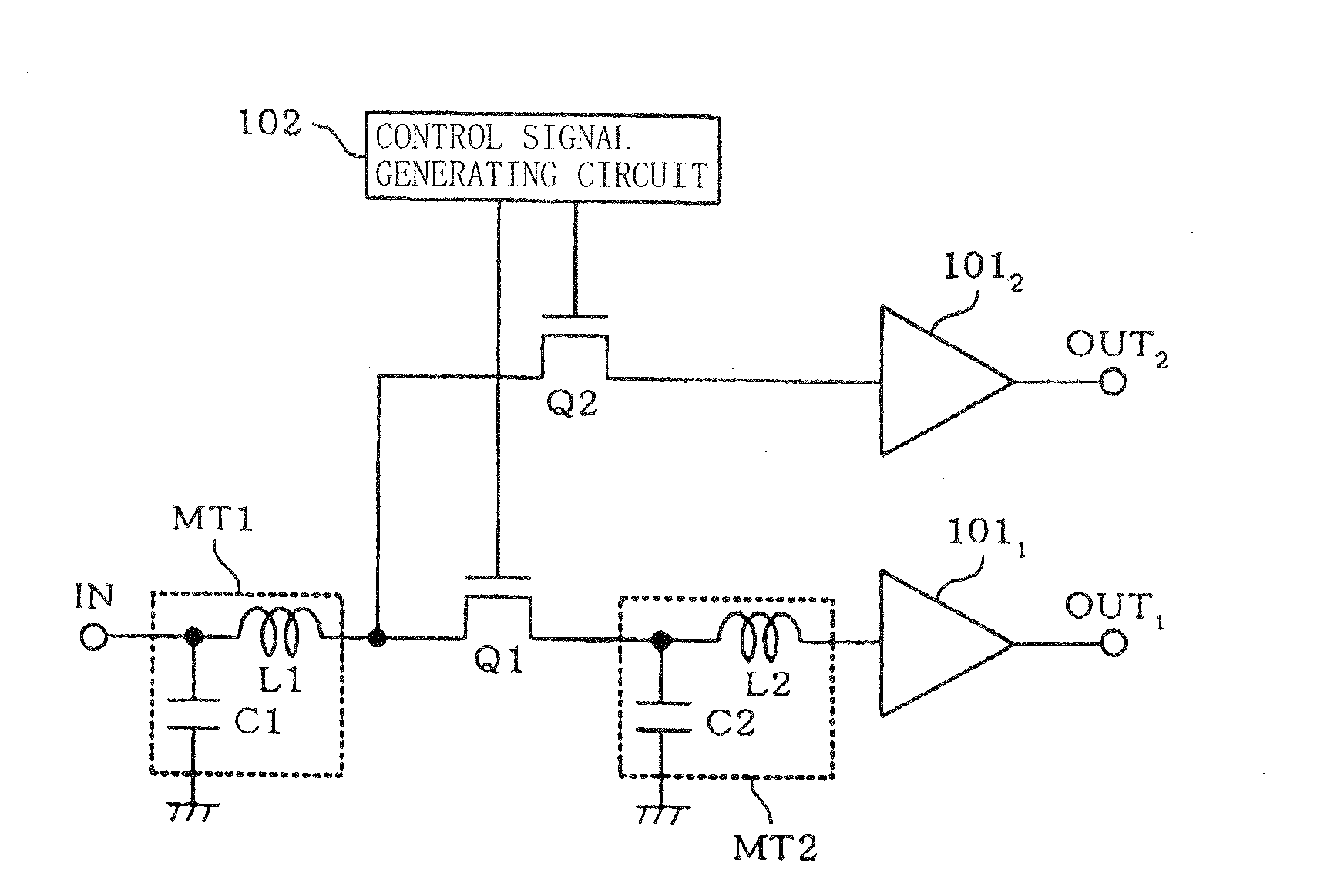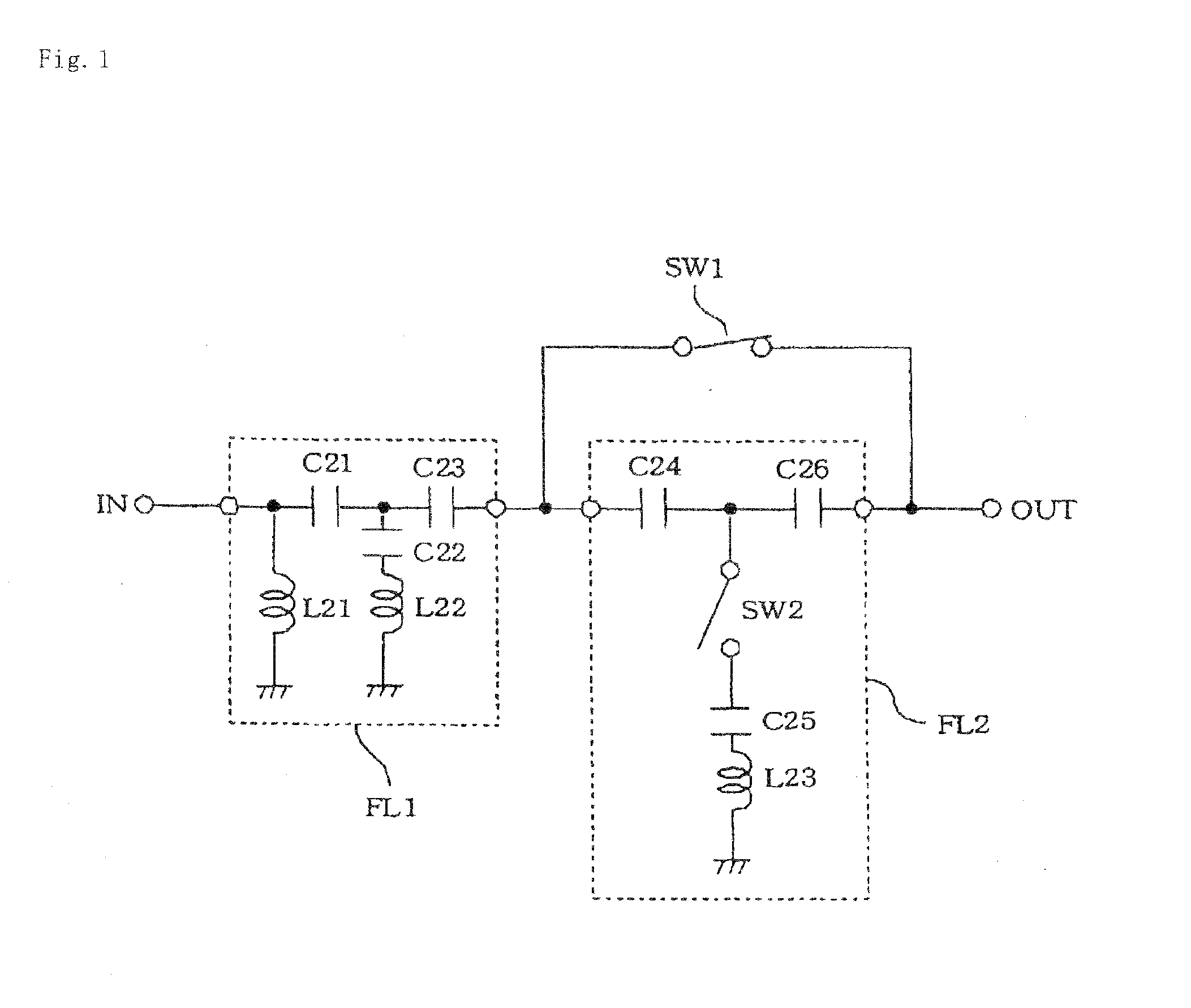Amplification circuit
a technology of amplifiers and circuits, applied in amplifiers, amplifiers with semiconductor devices/discharge tubes, amplifiers, etc., can solve problems such as increasing attenuation, and achieve the effect of wide dynamic range and good signal quality
- Summary
- Abstract
- Description
- Claims
- Application Information
AI Technical Summary
Benefits of technology
Problems solved by technology
Method used
Image
Examples
exemplary embodiment 2
[0105]FIG. 5 is a circuit diagram of a second exemplary embodiment of the present invention. In the present exemplary embodiment, amplifiers 1011, 1012 shown in FIG. 4 are replaced with single amplifier 101. Amplifier 101 includes inductor L11 and n-type MOSFETs Q11, Q12. MOSFET Q12 has a source electrode connected to ground, a gate electrode supplied with an RF signal in a high frequency band, and a drain electrode connected to output terminal OUT.
[0106]MOSFET Q11 has a source electrode grounded, a gate electrode supplied with an RF signal in a low frequency band, and a drain electrode connected to output terminal OUT. Inductor L11 is connected as a load on MOSFETs Q11, Q12 between power supply terminal Vdd and the drains of the respective transistors. The input RF signals are controlled by control signal generating circuit 102 such that only their desired frequency bands are propagated. Therefore, only one of the MOSFETs of amplifier 101 which is connected to the path in the desir...
exemplary embodiment 1
[0109]FIG. 7 is a circuit diagram of a third exemplary embodiment of the present invention. The circuit according to the present exemplary embodiment comprises two circuits according to the second exemplary embodiment which are connected parallel to each other. In FIG. 7, IN1, IN2 represent input terminals to which an RF signal is input, MT11, MT21; MT12, MT22 matching circuits, C11, C21; C12, C22 capacitors, L11, L21; L12, L22 inductors, Q11, Q21; Q12, Q22 n-type MOSFETs, and Q111, Q121; Q122, Q122 n-type MOSFETs having inductor L11 as a common load. Control signal generating circuit 102 selectively renders either one of MOSFETs Q11, Q21; Q12, Q22 to select a signal path.
[0110]If a plurality of frequency bands to be handled are largely different from each other, it is difficult to separate a high frequency band and a low frequency band from each other with a single signal path. Depending on the communication scheme, it may be necessary to connect a filter for removing interfering w...
exemplary embodiment 4
[0112]FIG. 8 is a circuit diagram of a fourth exemplary embodiment of the present invention. The circuit according to the present exemplary embodiment is different from the amplifying circuit according to the first exemplary embodiment in that it includes another matching circuit added to the RF signal path for the low frequency band and additionally includes an RF signal path for an intermediate frequency band. In FIG. 8, IN represents an input terminal to which an RF signal is input, OUT1 through OUT3 are an output terminal, MT1 through MT2 are matching circuits, C1 through C3 are capacitors, L1 through L3 are inductors, Q1 through Q4 are switching n-type MOSFETs, 1011 is an amplifier which operates in a low frequency band, 1012 an amplifier which operates in a high frequency band, 1013 is an amplifier which operates in an intermediate frequency band, and 102 is a control signal generating circuit for outputting control signals to MOSFETs Q1 through Q4 for selecting signal paths.
[...
PUM
 Login to View More
Login to View More Abstract
Description
Claims
Application Information
 Login to View More
Login to View More - R&D
- Intellectual Property
- Life Sciences
- Materials
- Tech Scout
- Unparalleled Data Quality
- Higher Quality Content
- 60% Fewer Hallucinations
Browse by: Latest US Patents, China's latest patents, Technical Efficacy Thesaurus, Application Domain, Technology Topic, Popular Technical Reports.
© 2025 PatSnap. All rights reserved.Legal|Privacy policy|Modern Slavery Act Transparency Statement|Sitemap|About US| Contact US: help@patsnap.com



